Not All Nitrates Are Bad for You—These 9 Foods Are High in Healthy Nitrates
Here's the difference between harmful and healthy nitrates in foods, plus their top benefits.

Liudmila Chernetska/Getty Images
Nitrates in food have long been associated with negative health consequences, putting many of us on high alert when we see food products with added nitrates, like processed meats. But there’s actually another side to the story where a handful of naturally nitrate-rich foods are actually good for us—an important piece of the nutrition puzzle and an overall balanced diet. Here’s the difference between the good nitrates and the less-good nitrates in food, and how this chemical compound can benefit your overall health.
Related: What Are High-Histamine Foods and Who Should Avoid Them?
What Exactly Are Nitrates?
“Nitrates are compounds made of nitrogen and oxygen that can be found in the body, but are also found naturally in foods or added to foods,” says Amy Davis, RD, LDN, registered dietitian at FRESH Communications. “Nitrates' impact on health can be a bit confusing, since naturally occurring and added nitrates seem to react differently in the body.”
Nitrates vs. Nitrites
Taking a small detour into chemistry here, a key concept to understanding the health impact of nitrogen-based compounds is knowing the difference between nitrates and nitrites. Nitrates and nitrites can either be added to food or naturally occurring in a food.
A nitrate (NO3) is a nitrogen atom bonded to three oxygen atoms.
A nitrite (NO2) is a nitrogen atom bonded to only two nitrogen atoms.
Nitrates are converted in the body into either beneficial nitric oxide or harmful nitrosamines.
When we consume nitrates, they can often be converted to nitrites in the body through bacteria in our mouth and gastrointestinal tract. These nitrites can then go on to become either beneficial nitric oxide or less desirable nitrosamines, each of which has a very different impact on the body.
“Nitrates that are naturally occurring in vegetables, for example, are converted to nitric oxide, which can relax blood vessels and help lower blood pressure. These nitrates may also help improve athletic endurance,” she explains. “On the other hand, after cooking meat at high temperatures, nitrates can turn into nitrosamines, which have been shown to increase the risk of cancer.”
Related: 9 Healthiest Vegetables to Eat, According to RDs
Then why are nitrates such a common additive to meat products? “Nitrates are added to meat for a few different purposes,” Davis explains. “They serve as a preservative to prevent bacterial growth, and they help retain the pink color of meats to avoid browning. Plus, they add a salty, umami flavor to these processed meats.”
The most common meats with added nitrates are the more processed and packaged meat options like bacon, sausage, hot dogs, ham, beef jerky and deli meats. This is why the World Health Organization (WHO) deemed processed meats as Group 1 substances, classifying them as carcinogenic to humans several years ago, and advising anyone at risk or concerned about their cancer risk to “consider reducing their consumption of red meat or processed meat until updated guidelines related specifically to cancer have been developed.” If you’re scoping out an ingredients list, sodium nitrate is usually the form of nitrate added to these types of products.
Beneficial Foods High in Nitrates
Meanwhile, there are plenty of extremely healthy foods whose natural nitrates are converted to nitric oxide in the body.
Celery
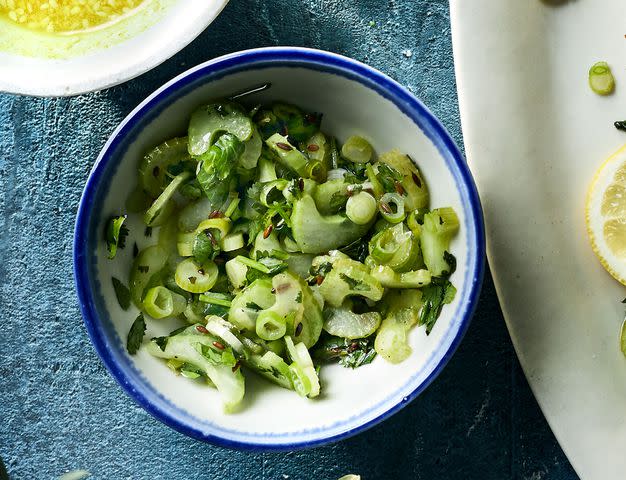
Celery is a naturally nitrate-rich food that transforms into health-boosting nitric oxide in the body. Whether celery is served raw and crunchy as a crudité or added to soups, salads, sauces, or chicken and tuna salad, it’s hard to beat the fresh and satisfying crunch of this fibrous, hydrating veggie.
Spinach
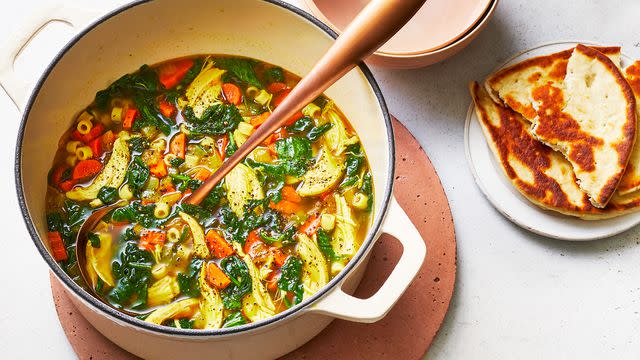
Curried Chicken Soup With Baby Spinach
Spinach is also a powerful source of healthy nitrates. One 2013 randomized control trial found that spinach consumption resulted in an eightfold increase in salivary nitrite concentration and was associated with greater artery elasticity and lower blood pressure levels in study participants. If you’re not already eating plenty of spinach , there are plenty of easy ways to integrate this versatile veggie (fresh or frozen, baby or regular) into your everyday life—add it to smoothies, salads, soups, rice, pasta, egg dishes, or simply sautée it with garlic and lemon for the perfect side dish.
Beets
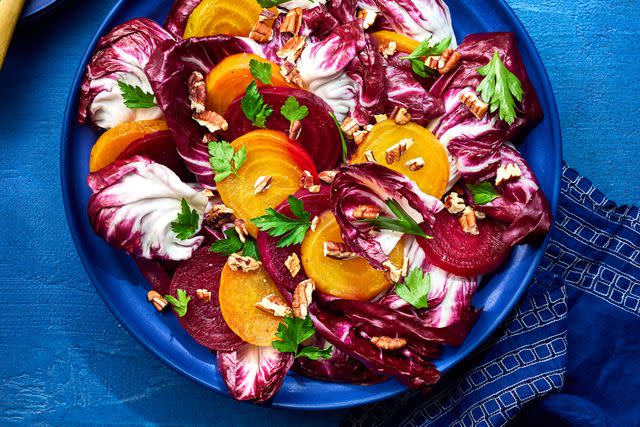
Victor Protasio
Beets don’t often get the positive press they deserve, but these brilliantly-colored root vegetables have a bevy of nutritional benefits, including the nitric oxide they produce as a result of their nitrate content. A 2018 study found that drinking beet juice increased nitric oxide levels by over 20 percent in just 45 minutes. These impressive stats have also been echoed in other studies, like this randomized control trial from 2016. If you’re not a plain-beet lover, try tossing beets or beet juice into a vibrant smoothie or shredding and stuffing them into tasty latkes.
Related: How to Cook Beets 8 Different Ways—Including Grilled, Roasted, and More
Lettuce

Healthy nitrates are also readily found in basically every variety of lettuce. So whether you love romaine, iceberg, butterhead, arugula, frisee, or watercress, all of these salad staples will help you reap the benefits of nitric oxide.
Garlic

Victor Protasio
Aside from all the healthy, anti-inflammatory plant compounds you’ll find in garlic, this aromatic vegetable can also help to boost nitric oxide levels. This benefit was found in a test tube study that discovered garlic intake restored the bioavailability of nitric oxide in blood vessel cells. Whether raw, roasted, or sauteed, there are few savory dishes that don’t benefit greatly from the addition of garlic in the flavor department.
Nuts and Seeds
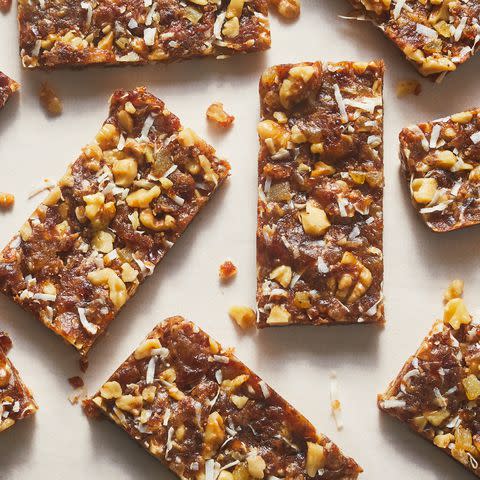
Another nutrient that helps to promote nitric oxide production in the body is the amino acid arginine. And nuts and seeds of all kinds are some of the best sources of arginine available. So, regardless of whether you opt for almonds, pistachios, walnuts, sunflower seeds, chia seeds, cashews, or otherwise, all of these options will help to boost heart health and athletic performance.
Citrus

Grapefruit Salad With Vanilla Syrup and Yogurt
Citrus fruits offer notable amounts of vitamin C, we know, but what you may not know is that these popular acidic fruits may help boost the bioavailability of nitric oxide, too. This is because vitamin C, or ascorbic acid, is actually linked with improved nitric oxide activity in the vascular system. Lemons, limes, grapefruit, and oranges (as well as any other citrus fruit you can think of) will all offer these benefits.
Watermelon
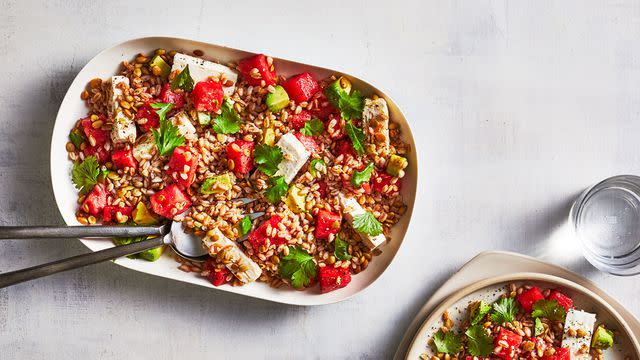
Feta and Watermelon Grain Bowls
Besides being delicious and hydrating, watermelon is another healthy food high in nitrates, due to its high citrulline concentration. Citrulline is a precursor to arginine, which then stimulates nitric oxide production.
Nitrate-Free Meats

Though the nitrates added to certain meat products get converted into problematic nitrosamines, non-processed meats can actually help you to reap the benefits of nitric oxide. Poultry, fish, or even red meat are all animal-based proteins naturally high in the co-enzyme CoQ10 that helps maintain good nitric oxide levels in the body. And thankfully, it’s easier than ever to find nitrate-free meat products these days. “Luckily the meat industry has adapted,” Davis says. “Many brands, such as Pederson's Farms and Applegate Farms offer nitrate-free meats. You can also visit your local butcher or farm to ensure higher-quality meats with no additives, including nitrates.”
Related: 9 Naturally Low-Sodium Foods to Reach for at the Supermarket
For more Real Simple news, make sure to sign up for our newsletter!
Read the original article on Real Simple.

